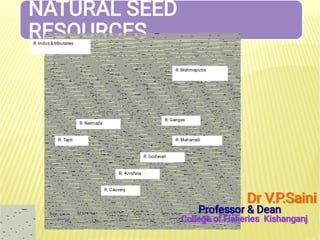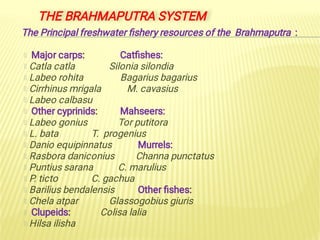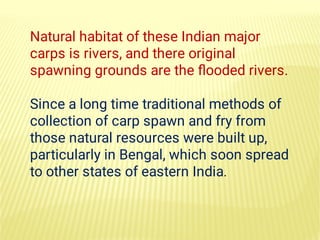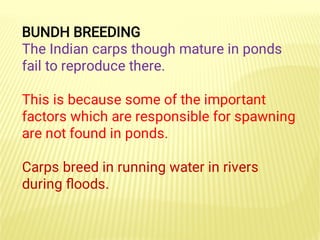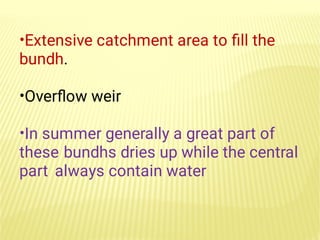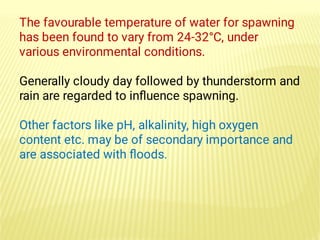Natural seed Resources of fishes of india .pdf
- 1. NATURAL SEED RESOURCES R. Indus & tributaries R. Narmada R. Tapti R. Cauvery R. Krishna R. Godavari R. Mahanadi R. Ganges R. Brahmaputra Dr V.P.Saini Professor & Dean College of Fisheries Kishanganj
- 2. SIGNIFICANCE OF SEED PROPAGATION With the increasing demand of flood control, dams are constructed which ultimately check the breeding migration of carps. Hence, the natural stock of carps in natural waters in depleting. Beside this, the potential for freshwater fish culture in India indicate a need for more than 34 billion fish fry every year. The present supply is much less than the target requirement of fish seeds. Therefore, the propagation of carp seed is must for increasing production from natural reservoirs as well as from the culture (pond) fishery, which is only possible by adopting the proper propagation techniques such as bundh breeding and induced breeding of carps.
- 3. NATURAL SEED RESOURC Revirine Breeding Bundh Breeding (a) Dry Bundh (b) Wet Bundh The collection of seed from riverine source was an age old practice.
- 4. India has five major river systems. Ganga river system Brahmaputra river system The Indus river system East coast river system West coast river system. R. Indus & tributaries R. Narmada R. Tapti R. Cauvery R. Krishna R. Godavari R. Mahanadi R. Ganges R. Brahmaputra
- 5. THE GANGA RIVER SYSTEM Harbors the richest freshwater fish fauna of India The Principal freshwater fishery resources of the Ganga : Indian major carps: Mahseer: Catla catla Tor putitora Labeo rohita T. mosal Cirrhinus mrigala T. tor Labeo calbasu Other carps: Larger catfishes: Labeo pangusia M. seenghala L .gonius Silonia silondia Cirrhinus reba Wallago attu L. dero Pangasius pangasius O. pabda Feather backs: Notopterus notopterus N. chitala Clupeids: Freshwater prawns: Hilsa ilisha Macrobrachium malcolmsoni
- 6. THE BRAHMAPUTRA SYSTEM The Principal freshwater fishery resources of the Brahmaputra : Major carps: Catfishes: Catla catla Silonia silondia Labeo rohita Bagarius bagarius Cirrhinus mrigala M. cavasius Labeo calbasu Other cyprinids: Mahseers: Labeo gonius Tor putitora L. bata T. progenius Danio equipinnatus Murrels: Rasbora daniconius Channa punctatus Puntius sarana C. marulius P. ticto C. gachua Barilius bendalensis Other fishes: Chela atpar Glassogobius giuris Clupeids: Colisa lalia Hilsa ilisha
- 7. THE INDUS SYSTEM Harbors the exotic rainbow and brown trout, variety of indigenous carps and catfishes The trout streams of Kashmir - one of the world’s richest sport fishing The Principal freshwater fishery resources of the Indus : Carps: Catfishes: Cyprinus carpio Glyptothorax kashmirensis Schizothorax sp G.reticulatum Tor putitora M. seenghala Labeo dero L. dyocheilus Other fishes: Puntius conchonius Botia sp Crossocheilus latius Nemacheilus sp
- 8. THE EAST COAST SYSTEM The east coast system in Peninsular constitutes the Mahanadi, the Godavari, the Krishna and the Cauvery The Mahanadi has all the Indian major carps common with the Ganga system Fish fauna -several carp species, catfishes, murrels, prawns, etc. along with the Gangetic carps from the north The tributaries of the Cauvery from the Nilgris have coldwater fishes like trout .
- 9. The Principal freshwater fishery resources of the Mahanadi : Carps: Catfishes: Catla catla M. seenghala L. rohita M. aor C. mrigala Rita rita L. fimbriatus R. chysea Mahseers: Tor mosal The Principal freshwater fishery resources of the Godavari : Carps: Catfishes: L. fimbriatus M. seenghala C. mrigala M. aor L. calbasu Silonia childreni Catla catla Wallago attu L. rohita Pangasius pangasius Bagarius bagarius Clupeids: Prawn Hilsa ilisha Macrobrachium malcolmsoni
- 10. The Principal freshwater fishery resources of the Krishna: Indian major carps: Catfishes: C. catla M. seenghala L. rohita M. aor C. mrigala Wallago attu Ompok bimaculatus Other carps: Murrels: L. fimbriatus Channa marulius L. kontius C. striatus P. sarana P. dubius The Principal freshwater fishery resources of the Cauvery : Major carps: Catfishes: C. catla Glyptothorax madrapatanus L. rohita M. seenghala C. mrigala M. aor L. calbasu Wallago attu Minor carps : Silonia silondia P. carnatius Other fishes: L. kontius Channa marulius C. reba Notopterus notopterus C. cirrhosa Tor khudree P. dubius
- 11. THE WEST COAST RIVER SYSTEM Includes the basins of the Narmada and the Tapti The other rivers that originate in the Western Ghats possess carps, catfishes, mahseers, murrels, perches, prawns, etc. The Principal freshwater fishery resources of the Narmada: Indian major carps: Catfishes: Catla catla Rita pavimentata L. rohita M. seenghala C. mrigala M. aor L. calbasu Wallago attu Clupisoma garua Other carps: M. bimaculatus L. fimbriatus Mystus cavasius L. bata L. gonius Miscellaneous fishes: C. reba Channa sp P. sarana Mastocembelus sp N. notopterus Tor tor
- 12. The Principal freshwater fishery resources of the Tapti Indian major carps: Other carps: L. calbasu L. fimbriatus C. mrigala P. sarana Catfishes: L. boggut M. seenghala L. bat O. aor Tor tor Wallago attu C. reba Clupisoma garua Other fishes: Channa sp Mastocembelus sp Other freshwater resources : Reservoir fish seed resources The reservoirs in Uttar Pradesh and Madhya Pradesh - natural stock of major carps The reservoirs - do not have a natural stock of major carps. Hence, major carp fingerlings produced elsewhere were brought and released in them.
- 13. Catla catla Labeo rohita Cirrhinus mrigala Labeo fimbriatus
- 14. Silver carp Grass carp Common carp
- 15. Coldwater fish seed resources Optimum temperature - 10-120C Trout, salmon and char: Trout and salmon - exotic game fishes introduced in India Trout species introduced : rainbow trout, brown trout, eastern brook trout, golden rainbow and tiger trout (a hybrid between brown trout x Salvelinus fontinalis) Peninsular India - in the Nilgiris and Kodai hills in Tamil Nadu and in the high ranges of erstwhile Travancore in Kerala In the Himalayas- Kashmir and Himachal Pradesh, in Garhwal Himalayas, Arunachal Pradesh, Nagaland, Meghalaya and in certain waters of Nepal
- 17. Mahseers: One of the world’s best game fishes Distributed in Himalayas and the Peninsular India Seven species of mahseer belonging to the genusTor in India They are:Tor tor , T. putitora ,T. khudree ,T. nelli ,T. progenius ,T. mussullah and T. mosal Snow trout : Snow trout ( Schizothorax spp.) are believed to have migrated into the lakes and streams of Kashmir from Central Asiatic watersheds There are eleven valid species ofSchizothorax Mahseers Snow trout
- 18. Hilsa, The anadromous Indian shad,Tenulosa ilisha (Hamilton)- commonly known as hilsa or river shad One of the most commercially important fish of the country Hilsa ascends the freshwater stretch of all the major river systems from sea mainly for breeding, thereby forming a lucrative fisheries in freshwater and brackish water. It’s upstream migration has greatly been hampered by the construction of dams, weirs and barrages across the rivers
- 19. MARINE FISH SEED RESOURCES The most important fish seed resources are: Milkfish: Distributed in the Indo-Pacific region; along both the coasts of India. ascends freshwater zones of river Grey-mullets: Distributed in the Indo-Pacific region Seabass: Occurs in the tropical and sub-tropical areas of Asia in coastal waters, estuaries and lagoons, including freshwater Pearlspot: Three species of pearlspot inhabit brackishwater and mouths of rivers in Orissa, Andhra Pradesh, Tamil Nadu, Kerala ands Karnataka
- 20. NATURAL BREEDING OF FINFISHES Most are seasonal breeders and their spawning coincides with seasonal changes in environmental factors In response to environmental stimuli, the hypothalamus secretes a hormone termed as releasing hormone (RH) The Nucleus Lateralis Tuberis (NLT) of the hypothalamus responds to an electrical signal from the brain by secreting RH at the end of the axon; thus an electric signal becomes a chemical one (bridging the gap between nervous/neural and hormonal information)
- 21. The arrangement of these neurons/axons is unique in teleosts, their axon directly end on gonadotropic cells in the adenohypophysis, but do not secrete their hormones into a portal blood system However, the effect of RH is to stimulate the production of GTH and its subsequent release into the vascular system of the adenohypophysis GTH is then carried in the general blood circulation to the gonads which in turn secrete steroids which are required for final maturation and spawning. The chain of events leading from the reception of environmental stimuli to maturation and release of gametes are as follows:
- 22. Temperature Photoperiod Rainfall Food supply Salinity Brain ↓ Hypothalamus ↓ RH Pituitary ↓ GtH Gonads ↓ Steroids Maturation & spawning
- 23. Collection of Seed from natural resources Availability of fish seed in large quantities is a primary requisite to develop fish culture in India. Indian major carps Catla ( Catla catla ), rohu ( Labeo rohita ) and mrigal ( Cirrhina mrigala ) are preferred for cultivation in freshwater ponds and tanks throughout the country.
- 24. Natural habitat of these Indian major carps is rivers, and there original spawning grounds are the flooded rivers. Since a long time traditional methods of collection of carp spawn and fry from those natural resources were built up, particularly in Bengal, which soon spread to other states of eastern India.
- 25. Fish seed trade even today depends on this resource in few places. With a view to providing scientific basis, seed prospecting investigations were initiated in various river systems of in India. Attempts were made to standardize the spawn collection nets, to evolve methods of collection and to ascertain factors responsible for fluctuations in the availability of fish seed in relation to time and place.
- 26. Site Selection for Seed Collection A pre-monsoon survey is conducted to ascertain the topography of the terrain and bank features at and in the vicinity of a site to determine the extent of operational area. The topography of dry beds and bank features to gauge the likely current pattern of the river at different stages of flooding. The distribution and composition of the fish fauna in the selected stretch of the river, resident or immigrant, for assessing the abundance of major carps during the monsoon season.
- 27. The location of tributaries, rivulets and canals along with their main river, as they might constitute important connecting links between the river and breeding grounds. The identity and accessibility of the site. The bends and curves of various shapes in the river course often show a precipitous, fast eroding bank on one side called erosion zone and a flat, gently sloping bank exactly opposite called shadow zone . These banks are not useful for spawn collection. Best seed collection sites lie on the side of the sloping bank but at the spot the current force the seed to the sides by centrifugal force. These spots are best to operate nets to collect large amounts of spawn.
- 30. EGG COLLECTION Large scale egg collection is possible only where locations of the breeding grounds are known and are easily accessible Eggs are collected from one or two feet deep water by disturbing the bottom and scooping them with a ‘ GAMCHA ’, a rectangular spawn collecting net Generally, large scale egg collection is not practiced in rivers Collection of riverine fish seed using agamcha
- 31. Generally shooting nets are used to collect the spawn in the rivers. A shooting net is a funnel-shaped net of finely woven netting, and is fixed with the mouth of the net facing the current. It is operated in the shallow margins of a flooded river. At the tail end of the net, there is a stitched - inring of split bamboo or cane, and to this is attached, during the operation, a receptacle, termed the gamcha. A gamcha is a rectangular open piece of cloth. The seed moving along with the marginal current collects in the gamcha, and is stored in hapas or containers after removal SPAWN COLLECTION Collection of spawn (up to 8 mm) on a commercial scale is prevalent mainly in Bihar, West Bengal and Uttar Pradesh
- 32. Benchi jal is used to collect the seed in Bengal. Midnapur net is also used in Bengal, especially in the south-western parts, to collect the seed. The shooting net is fixed in line with the water current direction. The bamboo poles are fixed firmly at the selected site and the net is fixed to bamboo poles. Two bamboo poles are fixed near the mouth and other two poles are fixed at tail ring. The anterior end of gamcha is then tied round the tail ring. The gamcha is fixed in position with the help of two more bamboo poles.
- 33. In order to select the spot of maximum availability of spawn within a specified stretch of the river concerned, a number of trial nets are simultaneously operated at a number of suitable spots. After selecting the spot, the operation is started with full battery of nets. Once it is done, the collection from the tail piece of each net is scooped one after the other in quick succession every 15 minutes or depending upon the intensity of spawn.
- 34. The contents of the gamcha are then scooped immediately in to a container half filled with river water. The collection is then passed through a mosquito netting sieve so that the unwanted organisms and non floating debris can be removed. The spawn are measured and kept in hapas for conditioning, then transported to fish farms and stocked in nurseries.
- 36. FRY AND FINGERLING COLLECTION The collection of fry (8-40 mm) and fingerlings (40-150 mm) is usually made by cast and drag nets. Fry and fingerling collection a source of fish seed is prevalent in the Indus river system in Punjab State A haul of fish fingerlings from a riverine stretch Fish seed being collected along the bank of a river
- 37. Floods and water current play an important role in the collection of seed. Flood: Floods show positive correlation with spawn. There may be three or more floods in a season. The pattern of flood is that the water first rises, then recedes. After few days again a second flood is caused and so on. Carps breed during floods in the rivers. FACTORE AFECTING SEED COLLECTION
- 38. In the first flood of the season the spawn of undesirable species is available. The major carp seed is available in subsequent floods. In between the floods the catches of major carp seed are less.
- 39. The availability of spawn are linked with the floods. In the receding phase of the floods results in the draining of spawn out of the breeding grounds down the river. Spawn is available both during day and night ; more seed is found in night catches.
- 40. Water Current: There is no effect on spawn when the water current is mild (0.086 km/hr). No significant effect is seen on spawn upto 0.4 km/hr water velocity. With increased water velocity all the spawn is carried away down the stream.
- 41. The slow and gentle current velocity varying from 0.5-3 km/hr is the best to collect the spawn. While faster currents of the mid-stream carry little spawn, low velocities of less than 1 km/hr are unfavorable for spawn catch. In deeper parts of the river, the spawn is not available due to non-generation of floods.
- 42. Other Factors: There is no effect of turbidity, pH and dissolved oxygen on spawn availability in the rivers. However, turbidity is associated with floods, and determines the efficiency of spawn collection. The turbidity reduces the mesh size of the net, and it is better to clean the nets at regular intervals. Air and water temperatures never show any effect on the spawn availability.
- 43. The optimal temperature is 28-31°C. Overcast conditions with breeze and with or without drizzle is found ideal for spawn collection. The stormy weather is totally unfavorable for spawn collection due to disorder currents and waves and the uprooting of shooting nets. .
- 44. Light also does not show any effect on spawn collection. The occurrence of plankton have no connection with the availability of spawn or its abundance in rivers. Spawn associations found abundant from the onset of monsoon dwindle thereafter to almost nil at the end of the season
- 45. ICES OF PAWN ANTITY AND UALITY Spawn quantity index: The desirable spawn taken by one standard net during a season is defined as the index of spawn quantity or yield of a centre Spawn quality index: Total percentage of major carp spawn available in a site Spawn categories (i) major carps (ii) minor carps (iii) others
- 47. BUNDH BREEDING The Indian carps though mature in ponds fail to reproduce there. This is because some of the important factors which are responsible for spawning are not found in ponds. Carps breed in running water in rivers during floods.
- 48. Some of the important factors reported to influence spawning of carps are:- Dissolved oxygen, flow of water, light, turbidity and temperature. Flooded rivers during the monsoons provide the necessary stimulus to the carps to breed. In bundh almost all the natural riverine conditions develop during rainy season which ultimately provide good breeding conditions for carps.
- 49. WHAT IS A BUNDH Bundhs are nothing but specialized type of ponds where riverine conditions are stimulated. They are constructed in the middle of a vast low laying area, with proper embankments and receive large quantities of rain water after heavy shower. Bundhs are provided with an outlet for the overflow of excess water and shallow areas which serve as spawning grounds for the fish.
- 50. Bundhs are generally of two types Perennial Bundh also called “Wet Bundh” Seasonal Bundh or the “Dry Bundh”
- 51. WHAT IS A WET BUNDH Perennial tanks or minor irrigation reservoirs where breeding takes place are called wet bundhs. The bundhs are filled with run-off water from extensive catchment areas during monsoon rain and create large shallow marginal area which serve as spawning grounds for the fish present in the bundh.
- 53. • • • FEATURES OF A WET BUNDH The main features of a wet bundh are as follows: Lateritic or sandy soil allowing fast runoff of the rain water. Sloping depression in an undulating terrain. Embankment to hold water throughout the year
- 54. • • • Extensive catchment area to fill the bundh. Overflow weir In summer generally a great part of these bundhs dries up while the central part always contain water
- 56. • • WHAT IS A DRY BUNDH A dry bundh is a seasonal shallow pond enclosed by an earthen wall (embankment) on three sides. FEATURES OF A DRY BUNDH The basic features of a dry bundh are the following. Shallow sloping depression in an undulating terrain. Lateritic or sandy soil allowing fast running of rain water
- 57. • • • • Large runoff area from catchment, having forest or uncultivated fields. Embankment to hold water of the first and subsequent rains. Shallow adjoining flooded breeding area An overflow screened weir.
- 58. TECHNIQUES OF BREEDING OPERATION Mature brooders are collected from perennial ponds before the onset of monsoon or during first showers and are kept separately sexwise in ponds preferably on a rainy day. Sufficient quantity of freshwater in bundhs is allowed to accumulate before the brooders are released. A ratio of one female to two males is followed preferably on a rainy day.
- 59. The stocking density of brooder varies from 3000-3500 kg/ha. In wet bundhs the brooder stock may be maintained throughout the year or replenished prior to monsoon. The brooders stimulate to spawn due to water current entering from catchment area.
- 60. Spawning in both types of bundhs occurs after continuous heavy showers, when large quantity of rain water rushes into the bundh. As soon as water accumulates in bundhs, a selected number of brooder are released spawning may occur at night.
- 61. Mrigal and rohu start breeding in the morning, while catla spawns from about noon to evening. Mrigala and rohu spawn in marginal shallow areas, while catla remain confined to relatively deeper water due to their deep body. Eggs are laid at intervals during which the pair keeps moving.
- 62. After spawning the spent fish move to the deeper water. Although Indian carps are inbreed to breed in bundhs, there is no information regarding breeding of Chinese carps in bundhs. It is believed that the Chinese carps which have more or less similar breeding habits as IMC can also be bred in bundhs.
- 63. FACTORS AFFECTING CARP BREEDING IN BUNDHS: Several factors are reported to be responsible for spawning of major carps in bundhs. Generally, spawning is stimulated by heavy monsoons that flood the shallow spawning areas. It is appears that availability of shallow spawning grounds inundated with fish rain water is an important factor in stimulating the breeders.
- 64. The favourable temperature of water for spawning has been found to vary from 24-32°C, under various environmental conditions. Generally cloudy day followed by thunderstorm and rain are regarded to influence spawning. Other factors like pH, alkalinity, high oxygen content etc. may be of secondary importance and are associated with floods.
- 65. COLLECTION AND HATCHING OF EGGS: After lowering the water level, eggs are collected by dragging a piece of mosquito net cloth. Collection of all the eggs are impossible especially in wet bundhs due to its larger area.
- 66. After collection of eggs, these are hatched in traditional hatching happa fixed in bundh itself or in nearly farm ponds. In west Bengal hatching of eggs are carried out in specially dug out earthen pits with mud plastered walls. However, in Rajasthan eggs are not collected, only the advanced fry on fingerlings are collected.
- 67. • PROBLEMS IN BUNDH BREEDING: The main problems encountered in bundh breeding are as follows: It is difficult to synchronise the collection of large quantities of eggs at a time, particularly in the case of wet bundh breeding.
- 68. • • • Serious problems were encountered during egg collection from bundh, due to entry of unwanted fishes and predatory insects. Although fertilization rate is high, still poor recovery is encountered. This can be improved by using modern hatcheries. Transportation of brooder cause great physical strain and suffer injuries. Therefore, facilities for brooder stocking ponds can be provided.
